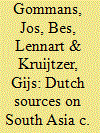| Srl | Item |
| 1 |
ID:
047007


|
|
|
|
|
| Publication |
New Delhi, Manohar Publishers and Distributors, 2001.
|
| Description |
424p.
|
| Contents |
Vol. 1: Bibliography and archival guide to the national archives at the Hague (The Netherlands)
|
| Standard Number |
8173043701
|
|
|
|
|
|
|
|
|
|
|
|
Copies: C:1/I:0,R:0,Q:0
Circulation
| Accession# | Call# | Current Location | Status | Policy | Location |
| 044508 | 015.492054/GOM 044508 | Main | On Shelf | General | |
|
|
|
|
| 2 |
ID:
149088


|
|
|
|
|
| Summary/Abstract |
From the fourteenth century CE onwards, South Indian states ruled by Hindu kings were strongly influenced by politico-cultural conventions from Muslim-governed areas. This development was, for instance, manifest in the dress and titles of the rulers of the Vijayanagara empire. As has been argued, they bore the title of sultan and on public occasions they appeared in garments fashioned on Persian and Arab clothing. Both adaptations exemplified efforts to connect to the dominant Indo-Islamic world. From Vijayanagara's fragmentation in the sixteenth and seventeenth centuries, new Hindu-ruled kingdoms arose. We may wonder to what extent those succeeding polities continued practices adopted from Islamic courts. With that question in mind, this article discusses royal dress at court audiences in four Vijayanagara successor states, chiefly on the basis of embassy reports of the Dutch East India Company and South Indian works of art. It appears that kings could wear a variety of clothing styles at audiences and that influences on these styles now came from multiple backgrounds, comprising diverse Islamic and other elements. Further, not all successor states followed the same dress codes, as their dynasties modified earlier conventions in different ways, depending on varying political developments.
|
|
|
|
|
|
|
|
|
|
|
|
|
|
|
|